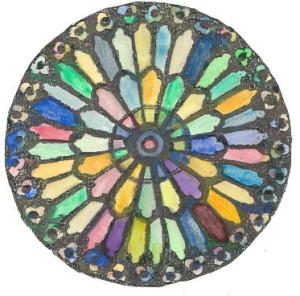An illustrated introduction to mandalas in various cultures leads to a discussion of bilateral, rotational, translational and expansion symmetry, as well as asymmetry. Using what they have learned about symmetry, students create their own mandalas, incorporating the use of both geometric and organic shapes. Advanced classes learn about associative law, additive identity, and group theory. Simultaneously, students are encouraged to develop an awareness of the universality of the human experience.
Mathematical Concepts
- Geometric shape review
- Symmetry is all around us
- Diameter, perpendicular, right angle, congruent
 In Tibet, elaborately and exquisitely decorated mandalas are made from colored sand which, when complete, are swept up and disposed of as part of a ritual. The process is a cross between visual art and performance art, since creating the mandala, sweeping it up and pouring it out is more important than the product itself. The entire ritual is meant to help bring about world harmony and peace. The Tibetan mandala is also used to assist meditation and concentration. This emphasis on process is also found in Navajo sand paintings. Rose windows like this one are an example of the use of mandalas in Western European culture.
In Tibet, elaborately and exquisitely decorated mandalas are made from colored sand which, when complete, are swept up and disposed of as part of a ritual. The process is a cross between visual art and performance art, since creating the mandala, sweeping it up and pouring it out is more important than the product itself. The entire ritual is meant to help bring about world harmony and peace. The Tibetan mandala is also used to assist meditation and concentration. This emphasis on process is also found in Navajo sand paintings. Rose windows like this one are an example of the use of mandalas in Western European culture.

